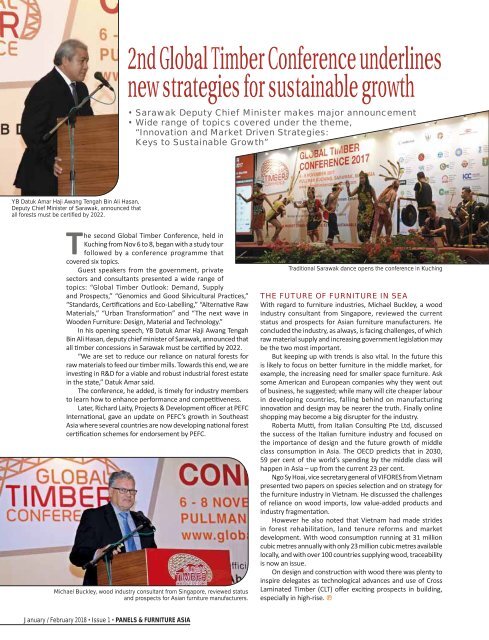Panels & Furniture Asia January/February 2018
Panels & Furniture Asia (PFA) is a leading regional trade magazine dedicated to the woodbased panel, furniture and flooring processing industry. Published bi-monthly since 2000, PFA delivers authentic journalism to cover the latest news, technology, machinery, projects, products and trade events throughout the sector. With a hardcopy and digital readership comprising manufacturers, designers and specifiers, among others, PFA is the platform of choice for connecting brands across the global woodworking landscape.
Panels & Furniture Asia (PFA) is a leading regional trade magazine dedicated to the woodbased panel, furniture and flooring processing industry. Published bi-monthly since 2000, PFA delivers authentic journalism to cover the latest news, technology, machinery, projects, products and trade events throughout the sector. With a hardcopy and digital readership comprising manufacturers, designers and specifiers, among others, PFA is the platform of choice for connecting brands across the global woodworking landscape.
You also want an ePaper? Increase the reach of your titles
YUMPU automatically turns print PDFs into web optimized ePapers that Google loves.
52 SHOW REVIEW<br />
2nd Global Timber Conference underlines<br />
new strategies for sustainable growth<br />
• Sarawak Deputy Chief Minister makes major announcement<br />
• Wide range of topics covered under the theme,<br />
“Innovation and Market Driven Strategies:<br />
Keys to Sustainable Growth”<br />
YB Datuk Amar Haji Awang Tengah Bin Ali Hasan,<br />
Deputy Chief Minister of Sarawak, announced that<br />
all forests must be certified by 2022.<br />
he second Global Timber Conference, held in<br />
Kuching from Nov 6 to 8, began with a study tour<br />
followed by a conference programme that<br />
covered six topics.<br />
Guest speakers from the government, private<br />
sectors and consultants presented a wide range of<br />
topics: “Global Timber Outlook: Demand, Supply<br />
and Prospects,” “Genomics and Good Silvicultural Practices,”<br />
“Standards, Certifications and Eco-Labelling,” “Alternative Raw<br />
Materials,” “Urban Transformation” and “The next wave in<br />
Wooden <strong>Furniture</strong>: Design, Material and Technology.”<br />
In his opening speech, YB Datuk Amar Haji Awang Tengah<br />
Bin Ali Hasan, deputy chief minister of Sarawak, announced that<br />
all timber concessions in Sarawak must be certified by 2022.<br />
“We are set to reduce our reliance on natural forests for<br />
raw materials to feed our timber mills. Towards this end, we are<br />
investing in R&D for a viable and robust industrial forest estate<br />
in the state,” Datuk Amar said.<br />
The conference, he added, is timely for industry members<br />
to learn how to enhance performance and competitiveness.<br />
Later, Richard Laity, Projects & Development officer at PEFC<br />
International, gave an update on PEFC’s growth in Southeast<br />
<strong>Asia</strong> where several countries are now developing national forest<br />
certification schemes for endorsement by PEFC.<br />
Michael Buckley, wood industry consultant from Singapore, reviewed status<br />
and prospects for <strong>Asia</strong>n furniture manufacturers.<br />
Traditional Sarawak dance opens the conference in Kuching<br />
THE FUTURE OF FURNITURE IN SEA<br />
With regard to furniture industries, Michael Buckley, a wood<br />
industry consultant from Singapore, reviewed the current<br />
status and prospects for <strong>Asia</strong>n furniture manufacturers. He<br />
concluded the industry, as always, is facing challenges, of which<br />
raw material supply and increasing government legislation may<br />
be the two most important.<br />
But keeping up with trends is also vital. In the future this<br />
is likely to focus on better furniture in the middle market, for<br />
example, the increasing need for smaller space furniture. Ask<br />
some American and European companies why they went out<br />
of business, he suggested; while many will cite cheaper labour<br />
in developing countries, falling behind on manufacturing<br />
innovation and design may be nearer the truth. Finally online<br />
shopping may become a big disrupter for the industry.<br />
Roberta Mutti, from Italian Consulting Pte Ltd, discussed<br />
the success of the Italian furniture industry and focused on<br />
the importance of design and the future growth of middle<br />
class consumption in <strong>Asia</strong>. The OECD predicts that in 2030,<br />
59 per cent of the world’s spending by the middle class will<br />
happen in <strong>Asia</strong> – up from the current 23 per cent.<br />
Ngo Sy Hoai, vice secretary general of VIFORES from Vietnam<br />
presented two papers on species selection and on strategy for<br />
the furniture industry in Vietnam. He discussed the challenges<br />
of reliance on wood imports, low value-added products and<br />
industry fragmentation.<br />
However he also noted that Vietnam had made strides<br />
in forest rehabilitation, land tenure reforms and market<br />
development. With wood consumption running at 31 million<br />
cubic metres annually with only 23 million cubic metres available<br />
locally, and with over 100 countries supplying wood, traceability<br />
is now an issue.<br />
On design and construction with wood there was plenty to<br />
inspire delegates as technological advances and use of Cross<br />
Laminated Timber (CLT) offer exciting prospects in building,<br />
especially in high-rise. ℗<br />
<strong>January</strong> / <strong>February</strong> <strong>2018</strong> • Issue 1 • PANELS & FURNITURE ASIA


















